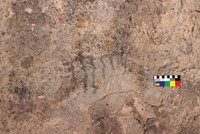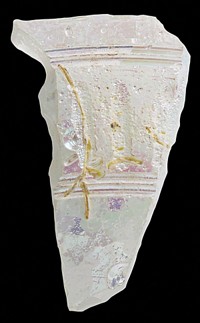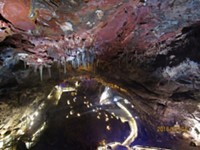Advertisement
Grab your lab coat. Let's get started
Welcome!
Welcome!
Create an account below to get 6 C&EN articles per month, receive newsletters and more - all free.
It seems this is your first time logging in online. Please enter the following information to continue.
As an ACS member you automatically get access to this site. All we need is few more details to create your reading experience.
Not you? Sign in with a different account.
Not you? Sign in with a different account.
ERROR 1
ERROR 1
ERROR 2
ERROR 2
ERROR 2
ERROR 2
ERROR 2
Password and Confirm password must match.
If you have an ACS member number, please enter it here so we can link this account to your membership. (optional)
ERROR 2
ACS values your privacy. By submitting your information, you are gaining access to C&EN and subscribing to our weekly newsletter. We use the information you provide to make your reading experience better, and we will never sell your data to third party members.
Analytical Chemistry
Digging Deeply Into The Past
Chemistry is increasingly helping archaeologists answer questions of what, where, and when
by Celia Henry Arnaud
April 24, 2006
| A version of this story appeared in
Volume 84, Issue 17

Modern archaeologists are detectives trying to solve the mysteries of the past. The word archaeologist conjures up the image of someone in the field painstakingly uncovering the foundations of ancient buildings or sifting through dirt to find rare artifacts. Such a notion of archaeology may seem more like history than science, but chemistry is now a key implement in the archaeologist's toolbox, from the radioactive carbon-14 used to estimate the age of objects to the trace elements used to figure out the origins of artifacts.
Archaeologists want to understand how people lived in earlier times. Scholars studying modern history can rely on the written record, supplemented by objects, to illuminate people's lives. For archaeologists, the written record is limited, if it exists at all. In many cases, the physical artifacts are all archaeologists have to go on, and they must reconstruct the past from the objects themselves and their present-day surroundings.
Chemistry can answer a number of questions that can help with this reconstruction: How old is an artifact? What is it made of? Where did it come from?
At the American Chemical Society national meeting held last month in Atlanta, a symposium on archaeological chemistry addressed these very questions as speakers described a variety of projects. The symposium, cosponsored by the Divisions of Nuclear Chemistry & Technology and of the History of Chemistry, was the 11th in a series going back more than 50 years. The symposia are held approximately every five years.
A major way that chemistry contributes to archaeology is in dating artifacts. In radioactive methods, the decay rate of a radioactive element in a sample and that element's half-life are used to estimate the age of the sample. The most prevalent technique by far uses carbon-14 and also requires a calibration based on the amount of that isotope in the atmosphere at any given point in the past, as measured in tree rings. Previously, the radioactive decay of carbon-14 was measured, but now the amount of carbon-14 can be measured directly by mass spectrometry.
Carbon-14's 5,730-year half-life makes it suitable only for dating of objects younger than 50,000 years, or about nine half-lives, because after that point too little carbon-14 remains to be measured. Other radioactive methods such as potassium-argon dating are suitable for samples that are millions of years old. That leaves a substantial time span in between.
At the ACS meeting, Anne R. Skinner, a senior lecturer at Williams College in Williamstown, Mass., described electron spin resonance (ESR) dating, one of the methods suitable for this intermediate age range. ESR dating measures the radicals generated by exposure to environmental radiation, typically from uranium and other radioactive elements and cosmic radiation. The age is then calculated by dividing the measured amount of radicals in the sample by the assumed annual dose, which is based on the environmental history of the surroundings.

The age range for which ESR dating works depends on the amount of time required to build up a detectable level of radicals. Typically, ESR dating can't be used for objects younger than a few thousand years. At the other end of the age range, samples older than 5 million to 8 million years tend to become saturated, and they can no longer be reliably dated by ESR.
ESR dating could help with one of the questions that archaeologists and paleontologists are trying to answer in Australia: Did the arrival of early humans in Australia drive large marsupial mammals such as the giant kangaroo and diprotodon, a bearlike animal, to extinction? The ESR dates of diprotodon teeth found in Australia's Lake Eyre Basin indicate that these marsupials still lived 43,000 years ago, while the first hominids arrived in Australia about 50,000 years ago, according to Skinner. The teeth had been deposited by water, so the site contained "a jumble of teeth of different ages," Skinner said. Therefore, she could only estimate a maximum age. Nonetheless, the teeth establish "an overlapping time between marsupials and hominids," she said. "One possible explanation is that [the marsupials] were hunted down."
Skinner measures carbonate radicals trapped within the hydroxyapatite of tooth enamel. "Teeth are the hardest substance in the body," Skinner said. Inside the hydroxyapatite crystals, she added, the free radicals are protected and can last for billions of years.
Sometimes, however, dating methods are needed for objects that are only a few hundred years old. Christopher M. Stevenson, an archaeologist at the Virginia Department of Historic Resources, in Richmond, described a method for dating glass objects based on the diffusion of water into their surfaces. He selected high-calcium glasses used in wine bottles because they were among the first to be brought to America and continued to be used until the 19th century. He focused on broken edges of the glass because he assumes that the time the bottle was broken corresponds to when the bottle was discarded. Otherwise, wine bottles of that era were reused repeatedly, so the age of the glass itself would not help date the deposit in which it was found.
To use the bottles as date markers, he first needed to establish a calibration curve for the rate at which water diffuses into glass containing different amounts of calcium. He measured the water diffusion and alkali exchange by infrared spectroscopy and secondary ion mass spectrometry. He and his coworkers then tested the calibration by determining the ages of bottles found in a trash deposit near the site of slave cabins at Monticello, Thomas Jefferson's plantation near Charlottesville, Va. They already knew that these were torn down around 1800. The estimated ages of the glass bottles determined with the calibration fell into that time period. Right now, the method is only precise enough to give them dates within a 50-year interval.

Despite these other techniques, carbon-14 dating is still the workhorse technique for archaeologists. Being able to use carbon-14 dating requires that the material contain at least some organic component. Graduate student Kathryn Duffy and her coworkers are investigating the pigment Maya blue, which is made by mixing the organic dye indigo with inorganic palygorskite clay, as a possible material for radiocarbon dating.
Scientists have generally considered Maya blue from an inorganic perspective, but Duffy wants to isolate the indigo so that it can be used for radiocarbon dating of murals. At the ACS meeting, she described a procedure for extracting the indigo by using hydrofluoric acid to etch away the mineral portion. The indigo is then irreversibly oxidized with nitric acid to isatin before it is radiocarbon dated. She and her colleagues demonstrated the extraction technique with mock samples of plaster with laboratory-made Maya blue on the surface.
Joseph B. Lambert, a professor at Northwestern University who has long been involved with archaeological chemistry, was intrigued by Duffy's talk. "It had never occurred to me that you could extract out the organic material and then carbon-14 date it," he told C&EN. "Maya blue as it appears on a wall painting or piece of pottery is never considered a source of organic materials. You can carbon date very small amounts. I'll be interested to see how the indigo project proceeds."
Age estimates are only meaningful in an archaeological context, however, if the artifacts can be connected with human activity. Ruth Ann Armitage, a chemistry professor at Eastern Michigan University in Ypsilanti, and her graduate student coworkers have been working to identify the black coating on rock paintings in Little Lost River Cave in Idaho. Archaeologists had obtained carbon-14 ages of the coating because it was plentiful and expendable, whereas the underlying painting was small. Archaeologists had theorized that the coating might be some sort of cooking residue. If the coating indeed results from such a human activity, its age can be used as a minimum age for the underlying paintings.
However, there have been questions about what the coating actually is. In Atlanta, Armitage's grad students Jamie A. Brown and Reshmi Perumplavil described the work they have done to nail down the true origin of the residue. They analyzed samples of the coating by using X-ray photoelectron spectroscopy and two different sample preparation methods for gas chromatography/mass spectrometry. Of all the comparison samples they tested, the coating least resembled their experimental cooking residues.
Instead, they found that the coating most closely resembled the common soil components humic and fulvic acids, suggesting that it was deposited by water dripping through the soil above the cave. The problem with trying to use humic and fulvic acids to date the coating is that those components can come from any layer of the soil, which could be older or younger than the underlying painting. "That's why you can't really date those if you're trying to date human activity," Armitage said. She is not ready to rule out an anthropogenic origin for some of the carbon that may be under the coating, but the evidence strongly supports an environmental origin for the coating itself.

In addition to ages of objects, archaeologists also want to know the geographic origins of objects that may wind up far from where they started. The composition of objects can help identify the source of the material. Knowing where something came from and where it ended up can provide clues to human migration or trade patterns. At the ACS symposium, such objects ranged from coins and pottery to trophy human heads.
Thomas R. Fenn, an anthropology graduate student at the University of Arizona, uses lead isotope ratios to identify the source of copper artifacts found in Western sub-Saharan Africa. (Even almost pure copper artifacts contain traces of lead carried through the smelting process from the ore.) The artifacts were found at four archaeological sites in West Africa. From the ratios of the four lead isotopes, Fenn suspects that much of the copper came from North Africa, even though there are copper deposits in West Africa. He is using this information to trace trade routes across the Sahara.
Sometimes, human remains are the best source of data for answering certain questions. Kelly J. Knudson, an assistant professor and director of the Archaeological Chemistry Laboratory at Arizona State University, described efforts to identify the origin of human heads found at sites used for rituals at the ancient Wari city of Conchopata, in the central Peruvian Andes. Tiffiny A. Tung, an archaeologist at Vanderbilt University, excavated and reconstructed the trophy heads, which the Wari, who preceded the Incas, had prepared by drilling a hole in the top and then smashing the skull. Archaeologists aren't sure whether the trophy heads came from the Wari's revered ancestors or from victims of warfare or raiding.
Determining the geographic origins of the trophy heads could provide one piece of evidence to identify the people. Knudson and her colleagues do this by measuring the isotope ratios of strontium in bone and tooth enamel. "Strontium gives us a really nice signature that allows us to track populations from different geologic zones," Knudson told C&EN. "It's not perfect, but it's the first technique we've had that allows us to look at human migration in the people themselves instead of looking at other artifacts."
The assumption is that strontium ratios reflect the ratios found in the surrounding geologic formations and that those ratios don't change as they are incorporated into food and move up the food chain. Because tooth enamel is set when a tooth forms, the strontium ratios in teeth reflect a person's environment from 10 weeks before birth to about 15 years of age, depending on the tooth. In contrast, bone is constantly regenerated throughout a person's life, so the strontium ratios in bone are indicative of the final five to 10 years of life.
First, Knudson needed to identify the modern strontium ratios at Conchopata. She did this by analyzing strontium ratios in locally raised guinea pigs. Then, Knudson and her collaborators analyzed bones and teeth from five adult trophy heads found at Conchopata. The strontium ratios in the bones and teeth differed, suggesting that the people were born somewhere else and later came to Conchopata. Thus, the heads were not likely used in ancestor worship. Because the collection of trophy heads includes women and children, they were most likely victims of raids rather than conventional warfare, Knudson said.
Advertisement
Sometimes, archaeologists can learn about a site just by analyzing the soil. E. Christian Wells, an archaeologist at the University of South Florida, Tampa, referred to "soil memory," which he defined as "how soil encodes the physical, biological, and chemical effects of human activities." It is based on soil particles carrying anions that attract cations, which are then fixed to the mineral surface through ion exchange. These cations can be analyzed and then mapped across an archaeological site.
Stuccoed surfaces are ideal for such analysis, Wells told C&EN, because they are made of materials that have been shown to trap and preserve a variety of chemical compounds over long periods of time. He is analyzing soil samples taken in a grid pattern from the stuccoed surfaces of a residential patio and a ceremonial plaza in Palmarejo, Honduras, to reconstruct activities in the area. For example, the analysis reveals that cooking was done at many places around the patio but only in limited areas of the plaza.
Archaeological chemists continue to improve the methods they use and to develop new ones. At the symposium, a number of presentations described two relatively recent additions to the archaeologist's tool kit for determining elemental composition: portable X-ray fluorescence (XRF) and laser-ablation inductively coupled plasma mass spectrometry (LA-ICP-MS). These techniques measure the elemental composition of an object, which provides a signature that can be used to trace its geographic origin.
The portable XRF unit is particularly useful for taking the analytical method to the archaeological site. Such mobility is valuable as increasingly restrictive laws make it more difficult to remove artifacts from their country of origin, said Robert J. Speakman, an archaeologist at the University of Missouri Research Reactor Center. He used portable XRF to analyze a variety of metal objects found in southern Peru. His colleagues at the Research Reactor Center have also used portable XRF to characterize obsidian deposits and objects made from them, as well as pottery.

Michael R. Notis, director of the Archaeometallurgy Laboratory in the department of materials science and engineering at Lehigh University, Bethlehem, Pa., used a handheld XRF instrument to analyze more than 700 Tyrian silver coins made between 138 B.C. and A.D. 53 and found in the hoards at the Isfiya and Qumran sites in Israel. Coins made around 44 B.C. contained smaller amounts of silver, but coins that were made later had larger amounts of silver. The later coins are marked "KP." Notis doesn't know what the letters stand for, but their inclusion correlates with stabilization of the silver content.
Other talks addressed LA-ICP-MS as a method for determining elemental composition with minimal sample damage. For example, Laure Dussubieux, manager of the LA-ICP-MS lab at the Field Museum of Natural History in Chicago, described the analysis of such artifacts as Wari ceramics and a variety of copper alloy objects, including bronze Matisse sculptures from the Baltimore Museum of Art. Such a small amount of material is needed that any damage "is invisible to the naked eye," she said.
These talks—only a sampling of the 35 presentations—show that chemistry is an integral part of modern archaeology. As the methods continue to improve, the relationship will only strengthen.





Join the conversation
Contact the reporter
Submit a Letter to the Editor for publication
Engage with us on Twitter